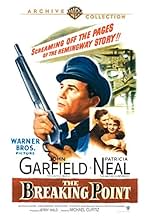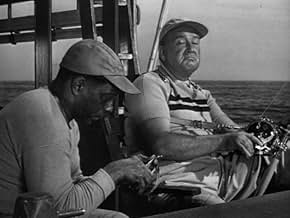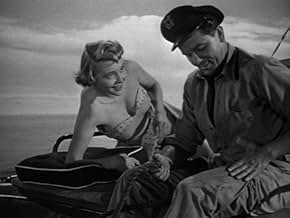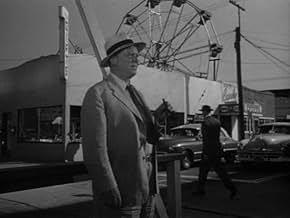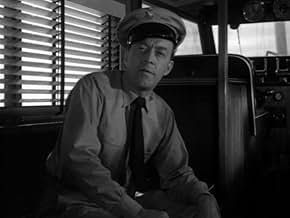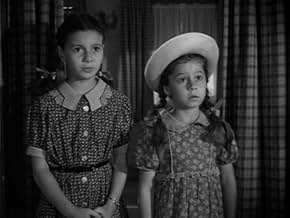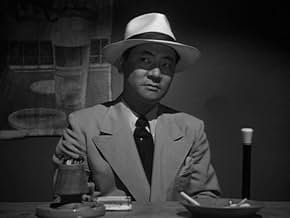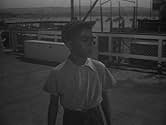CALIFICACIÓN DE IMDb
7.5/10
4.9 k
TU CALIFICACIÓN
El capitán de un barco de alquiler se ve en apuros económicos y se ve arrastrado a actividades ilegales para poder seguir pagando su barco.El capitán de un barco de alquiler se ve en apuros económicos y se ve arrastrado a actividades ilegales para poder seguir pagando su barco.El capitán de un barco de alquiler se ve en apuros económicos y se ve arrastrado a actividades ilegales para poder seguir pagando su barco.
- Dirección
- Guionistas
- Elenco
- Premios
- 4 premios ganados en total
John Alvin
- Reporter
- (sin créditos)
Chet Brandenburg
- Taxi Driver
- (sin créditos)
Peter Brocco
- Macho
- (sin créditos)
Mary Carroll
- Girl at Bar
- (sin créditos)
Spencer Chan
- 1st Chinese Immigrant
- (sin créditos)
John Close
- Deputy
- (sin créditos)
- Dirección
- Guionistas
- Todo el elenco y el equipo
- Producción, taquilla y más en IMDbPro
Opiniones destacadas
"The Breaking Point" is technically considered to be a remake of Ernest Hemingway's "To Have and Have Not," first brought to the screen with Bogie and Bacall. But it feels like a whole different story in just about every conceivable way. John Garfield excelled at playing prototypical noir heroes, desperate men doing desperate things when feeling trapped by an unfair fate. This is the role he has here, and watching his character dig himself deeper and deeper into shady doings that he knows are shady from the outset is like watching a slowly unfolding car accident. Patricia Neal is extremely fetching and knows how to deliver a sardonic one liner like no one's business, but the script doesn't do a whole lot with her other than have her appear here and there as window dressing. The stand out for me was Phyllis Thaxter as Garfield's plain Jane wife. It's refreshing in a film from 1950 to see a housewife portrayed as something other than a mindless cipher for her husband's thoughts and desires. Instead, she has a mind of her own and reserves of strength he might not give her credit for.
The most quietly astonishing thing about "The Breaking Point" is its treatment of Garfield's friend and ship assistant, a black man played by Juano Hernandez. The fact that he's black is a complete non-issue in the film. He's treated as an equal by Garfield and his family, and none of the stereotypes about black people that were so prevalent in movies from this time period, even in movies with their hearts in the right places, are present here. The final scene of the film involves this character's son, and it's so striking, and so devastating, that in retrospect the entire film almost seems to be about that scene even though it has almost nothing to do with everything that's come before it.
Michael Curtiz provides the no-frills direction.
Grade: A
The most quietly astonishing thing about "The Breaking Point" is its treatment of Garfield's friend and ship assistant, a black man played by Juano Hernandez. The fact that he's black is a complete non-issue in the film. He's treated as an equal by Garfield and his family, and none of the stereotypes about black people that were so prevalent in movies from this time period, even in movies with their hearts in the right places, are present here. The final scene of the film involves this character's son, and it's so striking, and so devastating, that in retrospect the entire film almost seems to be about that scene even though it has almost nothing to do with everything that's come before it.
Michael Curtiz provides the no-frills direction.
Grade: A
... He is the same guy as always, struggling against odds, railing about making it, etc., but toned down a bit. He takes umbrage but there is a restraint that is not present in his earlier more angry-young-man roles. Maybe because he looks as little filled out and older and is a family man to boot. There is a relative maturity in the character that is appealing. Despite playing the proverbial "same role" as some actors are thought of as doing, there is no sense that he is phoning it in. And he holds up more effective than ever with the ultimate no-nonsense imperative of tough guys. Tough but regular too, I like the opening sally, i.e., to the effect that when out to sea a certain tranquillity can reign but back on land nothing but trouble. I like that, especially with the ultimate irony to come.
The domestic scenes are not Hemingway, but added for the movie. A wonderful decision. It rounds out Garfield's character giving him a softer side and allows for the domestic sweetness and wholesome prettiness of Phyllis Thaxter to be his wife. I like to feel that her all-to-obvious new hairdo was not lost on her husband and that it might have helped him decide on another matter regarding a certain lady.
Garfield's remark to his 10-year-old daughter about being "too old to run around (the house) like that" (i.e., in night clothes) was a surprising but effective slice-of-life detail that perhaps only in a small way ushers in the new 50s sensibility regarding such matters that will make films more frank and real with youth (teens) issues.
Patricia Neal is stunning as the would-be femme fatale, - would-be because she falls short of treachery. Her worldly manner and sophisticated beauty provides a stark contrast to Garfield's women in the story. She wants to seduce, and pending the outcome, have the goods on him for revenge. Is she too sympathetic for this? Up in the air,,pending definitions. Reliable veteran character actor Wallace Ford has a good gig as a low-level conduit to the underworld. He has good dialogue, pushy and sarcastic with his own clients but totally subservient when around the big boys. A happy addition to the story. The poor boy alone on the pier resonates and is discomforting.
The domestic scenes are not Hemingway, but added for the movie. A wonderful decision. It rounds out Garfield's character giving him a softer side and allows for the domestic sweetness and wholesome prettiness of Phyllis Thaxter to be his wife. I like to feel that her all-to-obvious new hairdo was not lost on her husband and that it might have helped him decide on another matter regarding a certain lady.
Garfield's remark to his 10-year-old daughter about being "too old to run around (the house) like that" (i.e., in night clothes) was a surprising but effective slice-of-life detail that perhaps only in a small way ushers in the new 50s sensibility regarding such matters that will make films more frank and real with youth (teens) issues.
Patricia Neal is stunning as the would-be femme fatale, - would-be because she falls short of treachery. Her worldly manner and sophisticated beauty provides a stark contrast to Garfield's women in the story. She wants to seduce, and pending the outcome, have the goods on him for revenge. Is she too sympathetic for this? Up in the air,,pending definitions. Reliable veteran character actor Wallace Ford has a good gig as a low-level conduit to the underworld. He has good dialogue, pushy and sarcastic with his own clients but totally subservient when around the big boys. A happy addition to the story. The poor boy alone on the pier resonates and is discomforting.
No one played the haunted/hunted character better than John Garfield (Humphrey Bogart is a close second). Here, Garfield is a boat captain that gets in way over his head. The thing with Garfield's characters, is that even though the audience sympathizes with his plight, the character always brings it on himself. With Garfield's usual acerbic delivery, his Harry Morgan is hard to like but when he is with his family, one sees that he is basically a headstrong but good guy. Even though Michael Curtiz directed this, the tone and especially the ending shot kept reminding me of Fritz Lang. I think this film should be commended for the ending, which although a somewhat happy one, reminds the audience of the affect of one's actions on everyone. This generally was ignored in a lot of the crime dramas from the 30's to the 60's. My only complaint is the Patricia Neal character seemed tacked on for romance sake. She didn't add much and certainly didn't have an impact on the main thrust of the story. But that is a minor quibble. Another gem for one of the move overlooked actors - John Garfield.
With the Depression, the so-called "upper class," the subject of so many plays and films, began to fade and be replaced by the work of playwrights such as Clifford Odets.
John Garfield was the type of leading man who came out of that kind of working man play -- more rugged than romantic, more blue collar than white collar, more at home in a leather jacket than a tuxedo. That leading man type would peak post-war with the likes of Dean, Brando, Steiger, Newman, McQueen, and others. But their predecessor was John Garfield.
Here he stars in his second-last film, as he would soon be blacklisted -- it's "The Breaking Point," based on the Hemingway novel "To Have and Have Not," but not really like the Bogart-Bacall film, which borrowed the title.
In "The Breaking Point," Garfield plays Harry Morgan, who runs a charter boat in California. He has a wife, Lucy (Phyllis Thaxter) and two daughters (Sherry Jackson, Donna Jo Boyce). Times are tough (the original novel took place during the Depression) and Harry is having trouble making enough money to pay off his boat and raise his family.
Lucy wishes her husband would work for his father on his lettuce farm in Salinas, but Harry says all he knows is boats.
Because he needs money, Harry agrees to carry out a shady deal, transporting Chinese to the United States. But when he is cheated out of most of his money, he returns the men where he picked them up. However, someone rats on him and he nearly loses his boat.
When the boat's owner threatens to take the boat for nonpayment, Harry agrees to another shady deal; this one proves more dangerous.
Very intense film which also stars Juano Hernandez, who was wonderful in so many films until his death in 1970; Patricia Neal in her "babe" days, as a former boat passenger who is attracted to Harry; and Wallace Ford, as a foolish man involved in nefarious schemes. William Campbell, whose big claim to fame was that he was married to JFK's girlfriend Judith Exton, plays a low-level criminal.
John Garfield gives a brilliant performance as a stubborn, intense, desperate man who doesn't know where to turn. His last movie, He Ran All the Way, was a B movie and a clear indication that, thanks to the Communist witch hunt, he was on his way out. He died two years later.
Beautifully directed by Michael Curtiz, the end of the movie is especially poignant.
John Garfield was the type of leading man who came out of that kind of working man play -- more rugged than romantic, more blue collar than white collar, more at home in a leather jacket than a tuxedo. That leading man type would peak post-war with the likes of Dean, Brando, Steiger, Newman, McQueen, and others. But their predecessor was John Garfield.
Here he stars in his second-last film, as he would soon be blacklisted -- it's "The Breaking Point," based on the Hemingway novel "To Have and Have Not," but not really like the Bogart-Bacall film, which borrowed the title.
In "The Breaking Point," Garfield plays Harry Morgan, who runs a charter boat in California. He has a wife, Lucy (Phyllis Thaxter) and two daughters (Sherry Jackson, Donna Jo Boyce). Times are tough (the original novel took place during the Depression) and Harry is having trouble making enough money to pay off his boat and raise his family.
Lucy wishes her husband would work for his father on his lettuce farm in Salinas, but Harry says all he knows is boats.
Because he needs money, Harry agrees to carry out a shady deal, transporting Chinese to the United States. But when he is cheated out of most of his money, he returns the men where he picked them up. However, someone rats on him and he nearly loses his boat.
When the boat's owner threatens to take the boat for nonpayment, Harry agrees to another shady deal; this one proves more dangerous.
Very intense film which also stars Juano Hernandez, who was wonderful in so many films until his death in 1970; Patricia Neal in her "babe" days, as a former boat passenger who is attracted to Harry; and Wallace Ford, as a foolish man involved in nefarious schemes. William Campbell, whose big claim to fame was that he was married to JFK's girlfriend Judith Exton, plays a low-level criminal.
John Garfield gives a brilliant performance as a stubborn, intense, desperate man who doesn't know where to turn. His last movie, He Ran All the Way, was a B movie and a clear indication that, thanks to the Communist witch hunt, he was on his way out. He died two years later.
Beautifully directed by Michael Curtiz, the end of the movie is especially poignant.
I just saw this movie in the last week at a recent Film Noir Festival here in San Francisco. Garfield owns this role as a down on his luck captain of his boat. He is willing to take shady deals to make money for him and keep his family (his two young daughters) with money. His wife played by Phyllis Thaxter gives a fine turn as a wife and mother. Patricia Neal is smooth and dangerous in her role as a two timing blonde broad. The daughters that played the kids were effective and smart like their ages were depicted. Garfield's mate Wesley Park was very good in his role of Garfiled's suffering partner. The reptilian role of the attorney was convincing and nasty. The final minutes of the movie had me choked up with the performances from Garfield and Thaxter. Another great movie by Michael Curtiz. Why isn't this movie on DVD?
¿Sabías que…?
- TriviaAccording to TCM's Eddie Muller, John Garfield thought this was his best performance and that it was the film of which he was most proud.
- ErroresWhen she first steps onto the boat, Patricia Neal's voice is heard saying "we're off to sunny Mexico," but her lips aren't moving.
- Citas
Harry Morgan: You know, my wife dyed her hair.
Leona Charles: Coincidentally I've been thinking of letting mine grow out. Speaking of coincidences, I live in Number Seven. My friends just kick the door open.
- Créditos curiososTHE END close out. All lettering aligned and centered except for the line beneath Warner Bros. that begins PICTURES. It's left registered with whatever wording that followed it 'air brushed' over using the lower right drop shadow pattern leaving a Warner Bros. Pictures _?_?_?_?_ mystery.
- ConexionesFeatured in The John Garfield Story (2003)
- Bandas sonorasPlease Don't Talk About Me When I'm Gone
(uncredited)
Music by Sam H. Stept
Lyrics by Sidney Clare
Sung by Patricia Neal in the bar
Selecciones populares
Inicia sesión para calificar y agrega a la lista de videos para obtener recomendaciones personalizadas
- How long is The Breaking Point?Con tecnología de Alexa
Detalles
- Tiempo de ejecución1 hora 37 minutos
- Color
- Relación de aspecto
- 1.33 : 1
Contribuir a esta página
Sugiere una edición o agrega el contenido que falta



